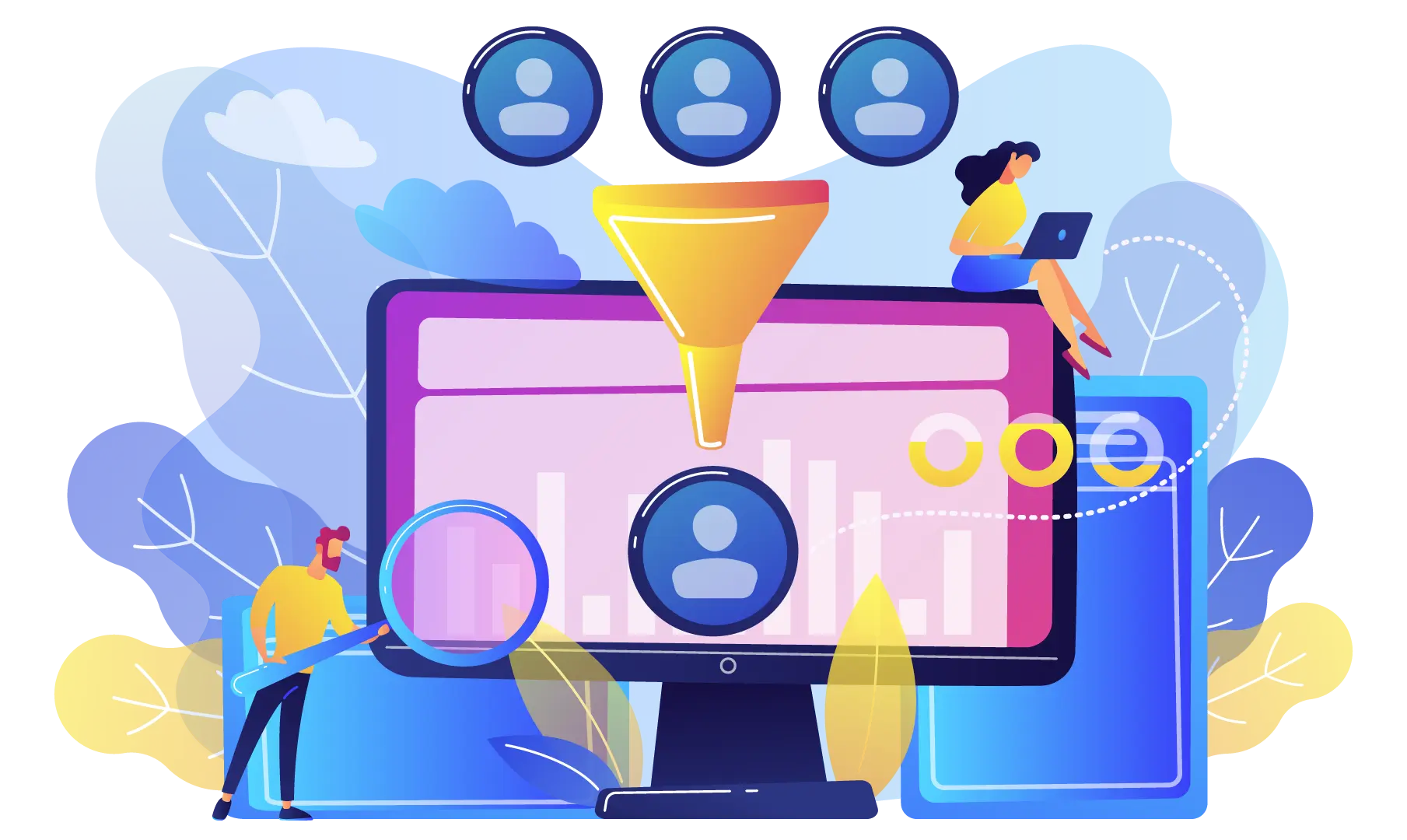
How Businesses Put Big Data To Work?
Learn how businesses across different industries leverage the power of big data analytics to improve revenue streams.
Let's dive in!
Last Updated On : 18 November, 2025
2 min read
Table of Contents
You probably have heard analysts mentioning the need for “business insights”. This can lead people without big data expertise to wonder what are business insights and how companies leverage data to increase business productivity. How exactly does big data analytics provide business intelligence?
While every organization has unique challenges to solve, the most popular big data use cases cut across industries and apply to a wide range of businesses.
In this blog post, we’ll discuss how data-driven decisions help companies to gain a competitive advantage and talk about the big data use cases in multiple industries.
But before diving deep into use cases, we should start by defining our terms.
What Is Big Data?
Big data is data in large volumes that grow exponentially. Big data comes from a wide range of sources and it can be in different forms.
Wow, that does sound quite vague, doesn’t it? Easier said than done, right?
Thankfully, Bernard Marr gives us the super easy-to-understand Big Data technique:
The basic idea behind the phrase 'Big Data' is that everything we do is increasingly leaving a digital trace (or data), which we (and others) can use and analyze. Big Data, therefore, refers to that data being collected and our ability to make use of it.
There is definitely no shortage of the use of big data. Innovative leaders are implementing big data initiatives to benefit from a wide range of big data analytics from enhanced customer experience, through new revenue streams to improved enterprise-wide performance.
Big Data Use Cases Across Different Industries
Big data-driven decisions help companies across multiple industries. Here are some of the use cases given below:
Finance Sector
Finance is traditionally a data-intensive sector. Data is flooded in both internal structured sources (trading systems, market data, compliance data, transactional data) and unstructured external sources (news, articles, customer feedback, and even third-party databases).
Financial institutions including banks and fintech harness the power of big data predictive analytics capabilities to gain a competitive advantage.
For instance, most financial companies leverage overflowing customer data such as demographics, behavior patterns, device data, and more to create detailed persona profiles. This advanced customer segmentation helps them create personalized marketing campaigns as well as prevent fraud.
But it didn’t stop there. Combining data analytics and machine learning helps fintech companies to predict certain events. This way fintech firms become better at risk assessment, which results in more financial certainty. A concise comparison of big data and ai highlights how data infrastructure enables modeling, while learning systems drive predictions and automation.
Some of the most renowned financial institutions recognize the power of big data. Even the most renowned bank JPMorgan Chase leverages big data.
“Artificial intelligence, big data, and machine learning are helping us reduce risk and fraud, upgrade service, improve underwriting, and enhance marketing across the firm.”CEO JPMorgan Chase
All in all, 76% of financial institutions are currently leveraging big data services. To further elaborate, 93% of these finance businesses use big data for customer analytics, 89% for risk assessment, and 86% for fraud detection. In addition, 86% use big data for security threat detection.
Healthcare Sector
With the increasing demand for digital solutions, the healthcare sector has the potential to gain the most from big data. The availability of ample data such as digitized medical records, medical imaging, clinical research, advances in genomics, as well as a variety of health solutions all led to a tech revolution in the healthcare industry.
Big data services not only help make sense of these massive data sets but also drive positive and life-saving outcomes.
Walmart relies on big data to get a real-time view of the workflow in the pharmacy, distribution centers, and throughout their stores and e-commerce.
Interestingly, 60% of healthcare organizations already use big data analytics, and nearly all remaining ones are open to adopting big data initiatives in the future.
By relying on data insights, physicians are better equipped to predict a patient's risk of developing a disease. And by accurately diagnosing the condition, not only can they reduce costs but also improve the quality of patient care.
Retail and eCommerce Sector
The retail industry is largely adapting to customer-centric services. The reason behind this shift is the competition that makes customer retention difficult. With a variety of options available, consumers easily switch brands at the slightest dissatisfaction.
To gain customer loyalty and eventually stay ahead of the competition, retailers utilize big data to understand customers’ browsing habits and shopping behavior. And thus become truly customer-centric.
According to Research and Markets, the global big data analytics market size is expected to reach $14.1 billion by 2026.
It comes as no surprise that retail companies invest in data analytics and predictive analysis. In the era when customers are highly connected, retailers sit on a data goldmine. Most of companies utilize this gold mine and improve their revenue streams.
The biggest retail company Amazon has approx 1 million Hadoop clusters to support their risk management, affiliate network, machine learning systems, and more.
The Bottom Line
Data is considered the oil of the 21st century.
Picture it this way, oil data is valuable but if unrefined it is of no use. Same as we have to change oil into petroleum, gas, and chemicals to create valuable products that drive revenue. We need to break Data down and streamline it for it to have value.
InvoZone’s big data engineers can assist you in creating data pipelines to transform real-time data into organized datasets that can be used for further analysis.

Don’t Have Time To Read Now? Download It For Later.
Table of Contents
You probably have heard analysts mentioning the need for “business insights”. This can lead people without big data expertise to wonder what are business insights and how companies leverage data to increase business productivity. How exactly does big data analytics provide business intelligence?
While every organization has unique challenges to solve, the most popular big data use cases cut across industries and apply to a wide range of businesses.
In this blog post, we’ll discuss how data-driven decisions help companies to gain a competitive advantage and talk about the big data use cases in multiple industries.
But before diving deep into use cases, we should start by defining our terms.
What Is Big Data?
Big data is data in large volumes that grow exponentially. Big data comes from a wide range of sources and it can be in different forms.
Wow, that does sound quite vague, doesn’t it? Easier said than done, right?
Thankfully, Bernard Marr gives us the super easy-to-understand Big Data technique:
The basic idea behind the phrase 'Big Data' is that everything we do is increasingly leaving a digital trace (or data), which we (and others) can use and analyze. Big Data, therefore, refers to that data being collected and our ability to make use of it.
There is definitely no shortage of the use of big data. Innovative leaders are implementing big data initiatives to benefit from a wide range of big data analytics from enhanced customer experience, through new revenue streams to improved enterprise-wide performance.
Big Data Use Cases Across Different Industries
Big data-driven decisions help companies across multiple industries. Here are some of the use cases given below:
Finance Sector
Finance is traditionally a data-intensive sector. Data is flooded in both internal structured sources (trading systems, market data, compliance data, transactional data) and unstructured external sources (news, articles, customer feedback, and even third-party databases).
Financial institutions including banks and fintech harness the power of big data predictive analytics capabilities to gain a competitive advantage.
For instance, most financial companies leverage overflowing customer data such as demographics, behavior patterns, device data, and more to create detailed persona profiles. This advanced customer segmentation helps them create personalized marketing campaigns as well as prevent fraud.
But it didn’t stop there. Combining data analytics and machine learning helps fintech companies to predict certain events. This way fintech firms become better at risk assessment, which results in more financial certainty. A concise comparison of big data and ai highlights how data infrastructure enables modeling, while learning systems drive predictions and automation.
Some of the most renowned financial institutions recognize the power of big data. Even the most renowned bank JPMorgan Chase leverages big data.
“Artificial intelligence, big data, and machine learning are helping us reduce risk and fraud, upgrade service, improve underwriting, and enhance marketing across the firm.”CEO JPMorgan Chase
All in all, 76% of financial institutions are currently leveraging big data services. To further elaborate, 93% of these finance businesses use big data for customer analytics, 89% for risk assessment, and 86% for fraud detection. In addition, 86% use big data for security threat detection.
Healthcare Sector
With the increasing demand for digital solutions, the healthcare sector has the potential to gain the most from big data. The availability of ample data such as digitized medical records, medical imaging, clinical research, advances in genomics, as well as a variety of health solutions all led to a tech revolution in the healthcare industry.
Big data services not only help make sense of these massive data sets but also drive positive and life-saving outcomes.
Walmart relies on big data to get a real-time view of the workflow in the pharmacy, distribution centers, and throughout their stores and e-commerce.
Interestingly, 60% of healthcare organizations already use big data analytics, and nearly all remaining ones are open to adopting big data initiatives in the future.
By relying on data insights, physicians are better equipped to predict a patient's risk of developing a disease. And by accurately diagnosing the condition, not only can they reduce costs but also improve the quality of patient care.
Retail and eCommerce Sector
The retail industry is largely adapting to customer-centric services. The reason behind this shift is the competition that makes customer retention difficult. With a variety of options available, consumers easily switch brands at the slightest dissatisfaction.
To gain customer loyalty and eventually stay ahead of the competition, retailers utilize big data to understand customers’ browsing habits and shopping behavior. And thus become truly customer-centric.
According to Research and Markets, the global big data analytics market size is expected to reach $14.1 billion by 2026.
It comes as no surprise that retail companies invest in data analytics and predictive analysis. In the era when customers are highly connected, retailers sit on a data goldmine. Most of companies utilize this gold mine and improve their revenue streams.
The biggest retail company Amazon has approx 1 million Hadoop clusters to support their risk management, affiliate network, machine learning systems, and more.
The Bottom Line
Data is considered the oil of the 21st century.
Picture it this way, oil data is valuable but if unrefined it is of no use. Same as we have to change oil into petroleum, gas, and chemicals to create valuable products that drive revenue. We need to break Data down and streamline it for it to have value.
InvoZone’s big data engineers can assist you in creating data pipelines to transform real-time data into organized datasets that can be used for further analysis.
Share to:

Written By:
Furqan AzizFurqan Aziz is CEO & Founder of InvoZone. He is a tech enthusiast by heart with 10+ years ... Know more
Get Help From Experts At InvoZone In This Domain